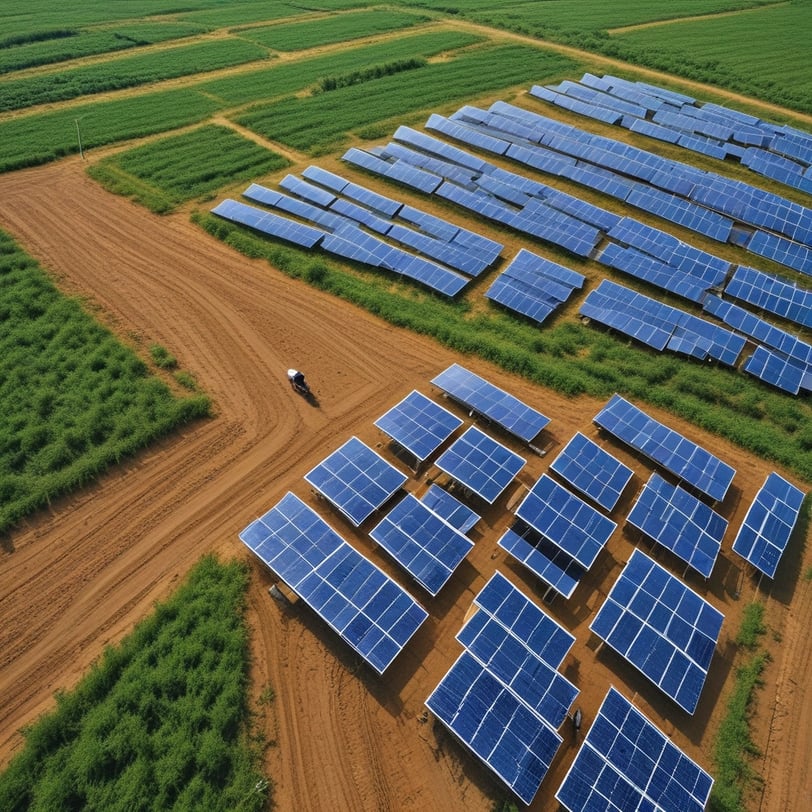Agrivoltaics: The Future of Farming and Solar Power
Agrivoltaics is creating ripples in agriculture and energy sectors. By combining traditional farming with solar energy generation, it's revolutionizing the way we utilize land. This emerging technology brings benefits that go beyond efficiency, promising a sustainable future for food and energy systems.
RENEWABLESOLAR ENERGY
Marius
1/7/20252 min read


Agrivoltaics: The Future of Farming and Solar Power
Agrivoltaics is creating ripples in agriculture and energy sectors. By combining traditional farming with solar energy generation, it's revolutionizing the way we utilize land. This emerging technology brings benefits that go beyond efficiency, promising a sustainable future for food and energy systems.
What is Agrivoltaics?
Agrivoltaics refers to the practice of integrating solar panels with agricultural practices. It allows farmers to grow crops beneath or around solar installations while simultaneously generating clean energy. The setup optimizes land use by serving two vital purposes: food production and renewable energy generation.
The Basics of Agrivoltaics
Agrivoltaics relies on careful planning. Solar panels are installed at a certain height and orientation to ensure light can still reach crops. The panels provide shade, reducing extreme heat stress on plants while maintaining energy output. This synergy creates an environment where both crops and solar panels thrive.
Farmers can adjust crop types, planting patterns, and irrigation systems to maximize efficiency. This dual-use system is especially valuable in regions facing land scarcity.
Historical Context
The concept of agrivoltaics originated in the early 2000s but has gained momentum in the last decade. France and Japan were early adopters, experimenting with this practice to address land-use challenges. Modern innovations and growing interest in sustainable methods are pushing agrivoltaics into the mainstream.
Benefits of Agrivoltaics
The advantages of agrivoltaics are numerous, stretching across economic, environmental, and agricultural sectors.
Land Use Efficiency
Agrivoltaics doubles land utility. Farmers don't need to choose between crops and energy production. This approach is crucial in densely populated or land-scarce regions. It’s an efficient solution to global land-use debates.
Increased Crop Yields
Studies show many crops perform better under the shade of solar panels. For example, lettuce grown in agrivoltaic systems displayed higher yields due to reduced heat stress. This makes agrivoltaics particularly useful in arid or semi-arid regions prone to extreme temperatures.
Environmental Impact
This system reduces the carbon footprint by combining renewable energy production with sustainable farming. Less fossil fuel dependency means fewer emissions. Additionally, solar panel installations encourage biodiversity, serving as habitats for pollinators and small wildlife.
Challenges Facing Agrivoltaics
Though promising, the adoption of agrivoltaics faces several hurdles.
Technical Limitations
Solar panel design is not one-size-fits-all for agricultural needs. Adjustments in panel height, spacing, and orientation are required. Moreover, not all crops are compatible with this system, limiting its application.
Regulatory Issues
Policies to guide agrivoltaics are often lacking. Land-use laws might restrict this dual purpose for farms. Additionally, obtaining permits for combined installations can be complicated and time-consuming.
Economic Considerations
The initial cost of setting up an agrivoltaic system is higher than traditional farming or standalone solar projects. Financial incentives and subsidies are often necessary for widespread adoption. Without them, small-scale farmers may struggle to implement these systems.
Future of Agrivoltaics
Agrivoltaics has a bright future as technology improves and awareness grows. Farmers, investors, and governments are starting to recognize its potential.
Research and Development Trends
Efforts are underway to develop smart agrivoltaic systems that use AI for optimization. These systems can monitor crop performance, predict energy output, and manage water usage, making the process even more efficient.
Potential Market Growth
The global agrivoltaics market is expanding. Countries like the U.S., India, and Germany are investing heavily in pilot projects. As technology gets cheaper and policies become clearer, adoption rates are expected to rise.
Conclusion
Agrivoltaics merges sustainability with efficiency, offering a practical solution to global challenges in food and energy systems. While hurdles remain, its potential is undeniable. By maximizing land use and fostering collaboration between farming and renewable energy industries, agrivoltaics sets the stage for a greener, more resilient future.
We use the best automation tools combined with cutting-edge software platforms and multichannel digital marketing strategies to drive your growth.
💖 Give Us Some Love! 💖
Copyright © 2024-2025 - Devaland Marketing Agency (DEVALAND MARKETING S.R.L.). All Rights Reserved.
We improve our products and advertising by using Microsoft Clarity to see how you use our website. By using our site, you agree that we and Microsoft can collect and use this data. Our Privacy Policy has more details.
Sitemap.xml
Company Legal Informations:
DEVALAND MARKETING S.R.L.
Romanian Fiscal Registration Code (C.I.F. / C.U.I.) - VAT Code: RO50841395
Date of Incorporation: November 07, 2024
VAT Registered: February 01, 2025
Special European Union Intra-Community VAT Code (EU VAT Code): RO51050828
VIES VAT Code Validation: https://ec.europa.eu/taxation_customs/vies/#/vat-validation
Trade Registry Unique European Union ID Code (EUID): ROONRC.J2024039063003
Trade Registry Romanian ID Code: J2024039063003
Business Address - Fiscal Registered Office:
Santandrei 13, Simeria 335903,
Hunedoara County, Transylvania, ROMANIA
Banking info:
IBAN code (EURO): RO11BTRLEURCRT0690462601
IBAN code (USD): RO15BTRLUSDCRT0690462601
IBAN code (RON): RO61BTRLRONCRT0690462601
Transylvania Bank, Deva Branch
SWIFT Code: BTRLRO22
PayPal Business Account: office@devaland.com
Revolut Business Account: On request
Stripe Business Account: Automation
CAEN Rev.3 code: 7311 - Activități ale agențiilor de publicitate
CAEN Rev.3 code: 7311 - Advertising Agencies
DEVALAND
MARKETING AGENCY
Slack: @devaland
Signal: @Marius13.13
Telegram: t.me/Devaland13
Skype: devaland
Contact Us:
USA Phone: +1 (620) 622-9695
Office Cell Phone: +40 (721) 269 312
Dubai Phone (Idriss): +1 (251) 930 6553
WhatsApp 1: +40 (721) 269 312
WhatsApp 2: +40 (740) 062 622
Email Office: office@devaland.com
Email Dubai: idriss@devaland.net
Email2: devaland@gmail.com
Marius Andronie
Manager / CEO
Mobile: +40 (721) 269 312
Email: office@devaland.com
Idriss, Dubai Office
COO / Chief Operating Officer
Mobile: +1 (251) 930 6553
Email: idriss@devaland.net











